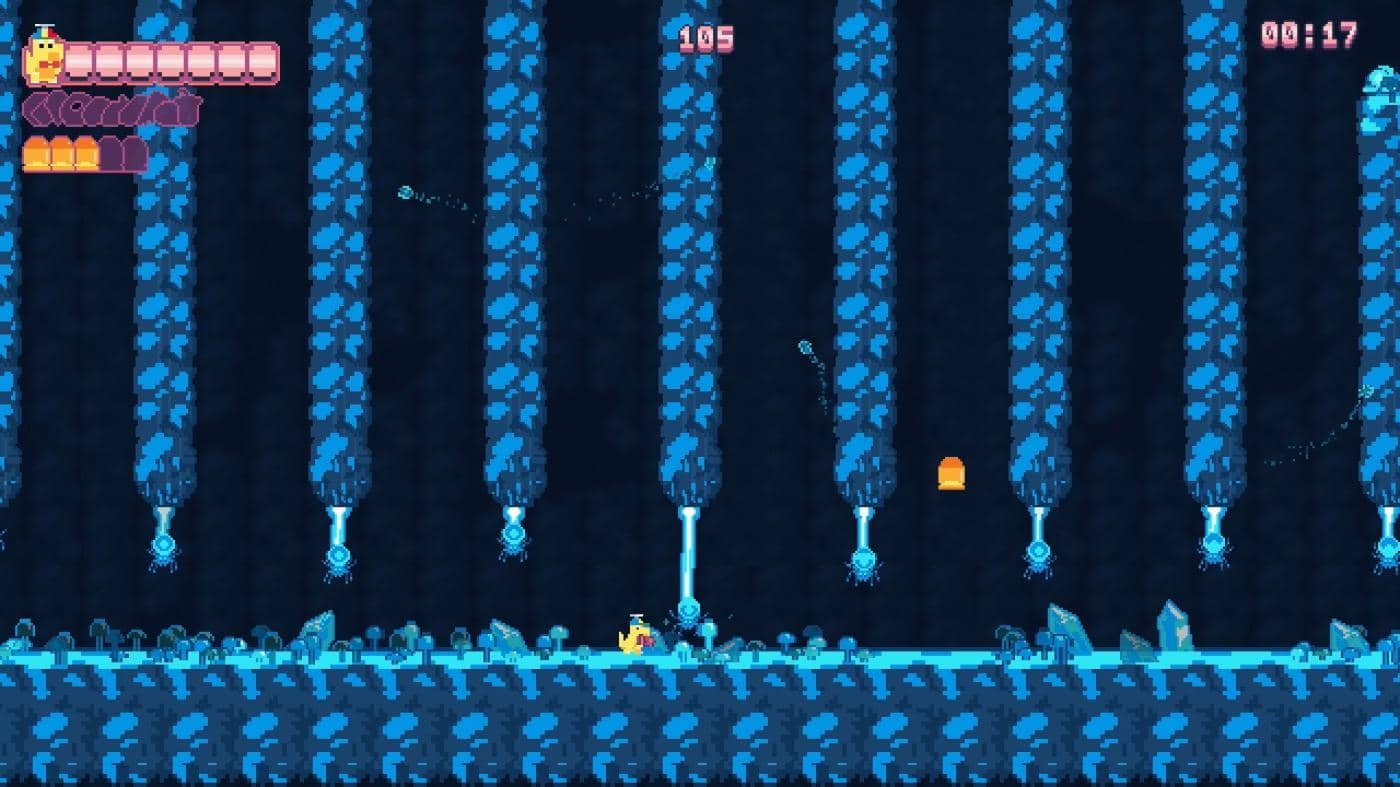Pffft. Cocos being enslaved by the Pogovon Empire? Give us a break. El Gancho sounds like child’s play. Ok… let’s smash through gameplay and get this review done in a few minutes. Wait: how is it you swing?
Part of the Task Force Kampas universe, the story might be a familiar one if you’ve already played the game. It’s not important as El Gancho isn’t narrative-driven but an action-platformer. There’s nothing unique about it at face value other than the throwback retro graphics. Though small, they’re pretty cool.
But that’s the tip of the iceberg, as it’s the controls that hog all the attention. First of all, the standard buttons are redundant as you’ll only use the shoulder/trigger buttons. L1 is jump, R2 is to shoot bouncing bullets, and R1 is the key to your success: the laser-hook.

An experimental weapon that your unnamed coco wields with… mixed results, the laser-hook is pivotal to the game as it enables the coco to swing around each level to rescue their brethren. The left analogue stick will move left and right, where the right stick moves a crosshair on screen, and this is your grappling point.
momentum is key, so if you can chain together enough accurate swings, it’s possible to glide through a level with finesse
El Gancho is suited to consoles, but a mouse would be much better for aiming. Like Spider-man, momentum is key, so if you can chain together enough accurate swings, it’s possible to glide through a level with finesse, rescuing other coco’s and whipping baddies along the way. But, it’s also easy to lose your place, fall off a ledge or two, or get zapped by an enemy, resulting in a game over.
It was a bit hit and miss for me, but that’s my skill level rather than a design flaw. The laser-hook is the focal point, and it needs to be mastered, and jumping and climbing a ledge will help (sticking to the walls like Ninja Gaiden is cool). Through progression, new playable cocos come loaded with unique skills ranging from speed to extra health. In addition to specific skills, random stages offer temporary power-ups, i.e. shields, along the way. Did I mention that El Gancho is procedurally-generated?
Combat is also tricky, but not as much as the actual swinging. The easiest and most effective option is the gun, but with limited ammo, swinging about to collect one bullet at a time can be cumbersome. These bullets bounce and don’t always hit the target. Instead, the coco can whip the enemies with their tail which doesn’t cost anything. The challenging part is again getting enough momentum as the greater the distance, the longer the trail/tail.

I couldn’t bear speedrunning with my skills – it’d be like pulling teeth, watching 24 hours of TikTok videos, or necking turds. That doesn’t mean you can’t, as the swinging mechanic is very good when competent. Take that one step further, and you’ll find there are individual Challenges in the main menu that are time-based. ‘Challenges’ is an apt choice as the enemies here are abundant. It’s tough-going but pretty damn enjoyable. Just keep an eye on that timer.
El Gancho is slightly different from other Eastasiasoft titles, as earning the platinum isn’t ridiculously easy. This is a good thing, in my opinion, as getting the platinum can be a deterrent for continuing the game. Achievements offer much more variety, ensuring you get the most of the game, collecting as much food as possible (doubles as extra lives and points), killing x number of enemies, and jumping so many times. You won’t jump that much unless you unlock the Astrococo with their ‘less gravity’ ability.
I mentioned that the game looked a little like Lemmings in places in the news post. As an Amiga veteran, this holds a lot of nostalgia for me, and as a result, El Gancho has a glow about it – like a low-key indie that would be free on a cover disc that you’d end up playing more than any triple-A or the “£500 value software” that came with it. Though challenging mechanics, Casiopea Wave’s indie might be worth a look if you’re a swinging VIP.










